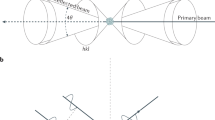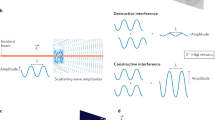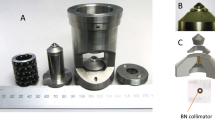Abstract
Isotopes are not normally considered to be distinguishable by X-ray crystal structure analysis. There is, of course, no problem as far as neutron diffraction is concerned, as neutron scattering amplitudes vary markedly and irregularly from one nuclide to another1. In particular, the neutron scattering amplitudes of protium and deuterium have opposite signs so that these two isotopes are especially easily identified. Indeed, in a key experiment nearly 20 yr ago, this difference was used together with the anomalous neutron scattering of 6Li to establish the absolute configuration of an enzymatically formed α-monodeuterioglycolic acid2. We discuss here the possibility of distinguishing deuterium from protium by X-ray diffraction on the basis of the difference in the vibrational behaviour of the two isotopic species.
This is a preview of subscription content, access via your institution
Access options
Subscribe to this journal
Receive 51 print issues and online access
$199.00 per year
only $3.90 per issue
Buy this article
- Purchase on Springer Link
- Instant access to full article PDF
Prices may be subject to local taxes which are calculated during checkout
Similar content being viewed by others
References
Bacon, G. E. Applications of Neutron Diffraction in Chemistry (Pergamon, Oxford, 1963).
Johnson, C. K., Gabe, E. J., Taylor, M. R. & Rose, I. A. J. Am. chem. Soc. 87, 1802–1804 (1965).
Dunitz, J. D. X-Ray Analysis and the Structure of Organic Molecules, Ch. 1 (Cornell University Press, Ithaca, 1979).
Ottersen, T. & Hope, H. Acta crystallogr. B35, 373–378 (1979).
Stevens, E. D. & Coppens, P. Acta crystallogr. B36, 1864–1876 (1980).
Ottersen, T., Almlöf, J. & Hope, H. Acta crystallogr. B36, 1147–1154 (1980).
Dunitz, J. D., Schweizer, W. B. & Seiler, P. Helv. chim. Acta 66, 134–137 (1983).
Hope, H. & Ottersen, T. Acta crystallogr. B34, 3623–3626 (1978).
Stevens, E. D. Acta crystallogr. B34, 544–551 (1978).
Savariault, J.-M. & Lehmann, M. S. J. Am. chem. Soc. 102, 1298–1303 (1980).
Shimanouchi, T. Tables of Molecular Vibraiional Frequencies, Consolidated Vol. I (NSRDS-NBS 39, US Department of Commerce, 1972).
Gawron, O. & Fondy, T. P. J. Am. chem. Soc. 81, 6333–6334 (1959).
Anet, F. A. L. J. Am. chem. Soc. 82, 994–995 (1960).
Bau, R. et al. Biochem. biophys. Res. Commun. 115, 1048–1052 (1983).
Versichel, W. van de Mieroop, W. & Lenstra, A. T. H. Acta crystallogr. B34, 2643–3645 (1978).
Ermer, O. & Dunitz, J. D. Acta crystallogr. A26, 163 (1970).
Seiler, P., Schweizer, W. B. & Dunitz, J. D. Acta crystallogr. (in the press).
Stewart, J. M., Kruger, G. J., Ammon, H. L., Dickinson, C. & Hall, S. R. The X-ray System, Version of June 1972 (Tech. Rep. TR192, University of Maryland, 1972).
Cromer, D. T. & Mann, J. B. Acta crystallogr. A24, 321–324 (1968).
Stewart, R. F., Davidson, E. R. & Simpson, W. T. J. chem. Phys. 42, 3175–3187 (1965).
Johnson, C. K. Ortep Rep. ORNL-3794 (Oak Ridge National Laboratory, Tennessee, 1965).
Author information
Authors and Affiliations
Rights and permissions
About this article
Cite this article
Seiler, P., Martinoni, B. & Dunitz, J. Can X-ray diffraction distinguish between protium and deuterium atoms?. Nature 309, 435–438 (1984). https://doi.org/10.1038/309435a0
Received:
Accepted:
Issue Date:
DOI: https://doi.org/10.1038/309435a0
This article is cited by
-
Experimental calibration of the reduced partition function ratios of tetrahedrally coordinated silicon from the Debye–Waller factors
Contributions to Mineralogy and Petrology (2021)
Comments
By submitting a comment you agree to abide by our Terms and Community Guidelines. If you find something abusive or that does not comply with our terms or guidelines please flag it as inappropriate.



